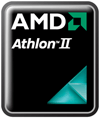Athlon II
Athlon II is a family of AMD multi-core 45 nm central processing units, which is aimed at the budget to mid-range market and is a complementary product lineup to the Phenom II.
 | |
| General Info | |
|---|---|
| Launched | 2009 |
| Marketed by | AMD |
| Designed by | AMD |
| Common manufacturer(s) | |
| Performance | |
| Max. CPU clock rate | 1.6 GHz to 3.5 GHz |
| HyperTransport speeds | 1.8 GHz to 2 GHz |
| Architecture and classification | |
| Min. feature size | 45 nm to 32 nm |
| Microarchitecture | AMD K10 |
| Instruction set | x86-64 |
| Physical specifications | |
| Cores |
|
| Socket(s) | |
| Products, models, variants | |
| Core name(s) |
|
| History | |
| Predecessor | Athlon X2 |
| Successor | FX |
Features
The Athlon II series is based on the AMD K10 architecture and derived from the Phenom II series. However, unlike its Phenom siblings, it does not contain any L3 Cache. There are two principal Athlon II dies: the dual-core Regor die with 1 MB L2 Cache per core and the four-core Propus with 512 KB per core. Regor is a native dual-core design with lower TDP and additional L2 to offset the removal of L3 cache.[2] The Athlon II x2 200e-220 chips have less L2 cache than the rest of the Regor line. The triple-core Rana is derived from the Propus quad-core design, with one core disabled. In some cases, the Phenom II Deneb die is used with disabled L3 cache and cores in the case.[3][4] Includes: AMD Direct Connect Architecture AMD Wide Floating Point Accelerator AMD Digital Media XPress 2.0 Technology AMD PowerNow! Technology (Cool’n’Quiet Technology) HyperTransport Technology (not the same as Intel Hyper-Threading Technology)
Processors with an "e" following the model number (e.g., 245e) are low-power models, typically 45W for Athlons, 65W for Phenoms. Processors with a "u" following the model number (e.g., 250u) are ultra-low voltage models.
| AMD Athlon II-based processor family | ||||||
|---|---|---|---|---|---|---|
| AMD K10 | Quad-core | Dual-core[5] | Quad-core | Triple-core | Dual-core | Single-core |
| Codename | Llano | Propus | Rana | Regor | Sargas | |
| Lithography | 32 nm | 45 nm | ||||
| Socket | FM1 | AM3 | ||||
| Date released | Aug 2011 | Feb-Jun 2012 | Sep 2009 | Nov 2009 | Jun 2009 | Aug 2009 |
- For a list of Socket AM3 Athlon II microprocessors, see: List of AMD Phenom microprocessors
- For a list of Socket FM1 Athlon II microprocessors, see: List of AMD accelerated processing unit microprocessors
Features table
CPU features table
Cores
Regor (45 nm SOI with immersion lithography)
- Two AMD K10 cores (Some are chip harvested Propus or Deneb with two cores disabled[6])
- L1 cache: 64 kB + 64 kB (data + instructions) per core
- L2 cache: 1024 kB per core, full-speed (512 kB per core in Athlon II X2 200e-220)
- Memory controller: dual channel DDR2-1066 MHz (AM2+), dual channel DDR3-1333 (AM3) with unganging option
- MMX, Extended 3DNow!, SSE, SSE2, SSE3, SSE4a, AMD64, Cool'n'Quiet, NX bit, AMD-V
- Socket AM3, HyperTransport with 2 GHz
- Die Size: 117 mm² [7]
- Power consumption (TDP): 25-65 Watts
- First release
- June 2009 (Stepping C2)
- Clock rate: 1.6 - 3.6 GHz
- Models: Athlon II X2 250u - 280
Rana (45 nm SOI with immersion lithography)
- Three AMD K10 cores chip harvested from Propus or Deneb with one core disabled[6]
- L1 cache: 64 kB + 64 kB (data + instructions) per core
- L2 cache: 512 kB per core, full-speed
- Memory controller: dual channel DDR2-1066 MHz (AM2+), dual channel DDR3-1333 (AM3) with unganging option
- MMX, Extended 3DNow!, SSE, SSE2, SSE3, SSE4a, AMD64, Cool'n'Quiet, NX bit, AMD-V
- Socket AM3, HyperTransport with 2 GHz
- Die Size: 169 mm² [7]
- Power consumption (TDP): 45 Watts or 95 Watts
- First release
- October 2009 (Stepping C2)
- Clock rate: 2.2–3.4 GHz
- Models: Athlon II X3 400e - 460
Propus (45 nm SOI with immersion lithography)
.jpg)
- Four AMD K10 cores chip harvested from Deneb with L3 cache disabled[6]
- L1 cache: 64 kB + 64 kB (data + instructions) per core
- L2 cache: 512 kB per core, full-speed
- Memory controller: dual channel DDR2-1066 MHz (AM2+), dual channel DDR3-1333 (AM3) with unganging option
- MMX, Extended 3DNow!, SSE, SSE2, SSE3, SSE4a, AMD64, Cool'n'Quiet, NX bit, AMD-V
- Socket AM3, HyperTransport with 2 GHz
- Die Size: 169 mm² [7]
- Power consumption (TDP): 45 Watts or 95 Watts
- First release
- September 2009 (Stepping C2)
- Clock rate: 2.2–3.1 GHz
- Models: Athlon II X4 600e - 645, Phenom II x4 840
External links
- AMD Athlon II 170u - AD170UEAK13GM
- AMD Introduces Next Generation AMD Athlon II Processor, Adds Dual Core to Record-Setting AMD Phenom II
- Athlon II X4 620: AMD's new Quad-Core CPU reviewed
- Athlon II X2 220 unlocks into Phenom II 920
- Shvets, Gennadiy. "Obscure CPUs: Sempron X2 198 and Athlon II X2 221". CPU World. Retrieved 3 March 2016.
- https://docs.google.com/spreadsheets/d/19Ms49ip5PBB7nYnf5urxsySvH-Sdy6liE2EBDaB8b54
- "AMD Phenom II X6: Thuban the Dragon". Archived from the original on 2014-02-28. Retrieved 2011-02-07.